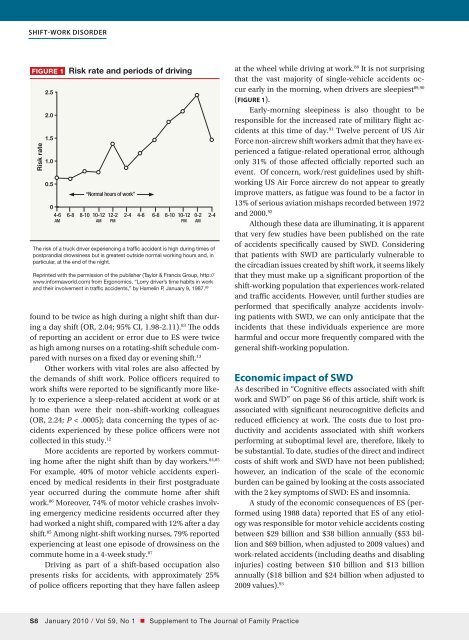Shift-work disorder - myCME.com
Shift-work disorder - myCME.com
Shift-work disorder - myCME.com
You also want an ePaper? Increase the reach of your titles
YUMPU automatically turns print PDFs into web optimized ePapers that Google loves.
<strong>Shift</strong>-<strong>work</strong> <strong>disorder</strong><br />
Figure 1 Risk rate and periods of driving<br />
Risk rate<br />
2.5<br />
2.0<br />
1.5<br />
1.0<br />
0.5<br />
“Normal hours of <strong>work</strong>”<br />
0<br />
4-6 6-8 8-10 10-12 12-2 2-4 4-6 6-8 8-10 10-12 0-2 2-4<br />
am am pm pm am<br />
The risk of a truck driver experiencing a traffic accident is high during times of<br />
postprandial drowsiness but is greatest outside normal <strong>work</strong>ing hours and, in<br />
particular, at the end of the night.<br />
Reprinted with the permission of the publisher (Taylor & Francis Group, http://<br />
www.informaworld.<strong>com</strong>) from Ergonomics. “Lorry driver’s time habits in <strong>work</strong><br />
and their involvement in traffic accidents,” by Hamelin P, January 9, 1987. 89<br />
found to be twice as high during a night shift than during<br />
a day shift (OR, 2.04; 95% CI, 1.98-2.11). 83 The odds<br />
of reporting an accident or error due to ES were twice<br />
as high among nurses on a rotating-shift schedule <strong>com</strong>pared<br />
with nurses on a fixed day or evening shift. 13<br />
Other <strong>work</strong>ers with vital roles are also affected by<br />
the demands of shift <strong>work</strong>. Police officers required to<br />
<strong>work</strong> shifts were reported to be significantly more likely<br />
to experience a sleep-related accident at <strong>work</strong> or at<br />
home than were their non–shift-<strong>work</strong>ing colleagues<br />
(OR, 2.24; P < .0005); data concerning the types of accidents<br />
experienced by these police officers were not<br />
collected in this study. 12<br />
More accidents are reported by <strong>work</strong>ers <strong>com</strong>muting<br />
home after the night shift than by day <strong>work</strong>ers. 84,85<br />
For example, 40% of motor vehicle accidents experienced<br />
by medical residents in their first postgraduate<br />
year occurred during the <strong>com</strong>mute home after shift<br />
<strong>work</strong>. 86 Moreover, 74% of motor vehicle crashes involving<br />
emergency medicine residents occurred after they<br />
had <strong>work</strong>ed a night shift, <strong>com</strong>pared with 12% after a day<br />
shift. 85 Among night-shift <strong>work</strong>ing nurses, 79% reported<br />
experiencing at least one episode of drowsiness on the<br />
<strong>com</strong>mute home in a 4-week study. 87<br />
Driving as part of a shift-based occupation also<br />
presents risks for accidents, with approximately 25%<br />
of police officers reporting that they have fallen asleep<br />
at the wheel while driving at <strong>work</strong>. 88 It is not surprising<br />
that the vast majority of single-vehicle accidents occur<br />
early in the morning, when drivers are sleepiest 89,90<br />
(FIGURE 1).<br />
Early-morning sleepiness is also thought to be<br />
responsible for the increased rate of military flight accidents<br />
at this time of day. 91 Twelve percent of US Air<br />
Force non-aircrew shift <strong>work</strong>ers admit that they have experienced<br />
a fatigue-related operational error, although<br />
only 31% of those affected officially reported such an<br />
event. Of concern, <strong>work</strong>/rest guidelines used by shift<strong>work</strong>ing<br />
US Air Force aircrew do not appear to greatly<br />
improve matters, as fatigue was found to be a factor in<br />
13% of serious aviation mishaps recorded between 1972<br />
and 2000. 92<br />
Although these data are illuminating, it is apparent<br />
that very few studies have been published on the rate<br />
of accidents specifically caused by SWD. Considering<br />
that patients with SWD are particularly vulnerable to<br />
the circadian issues created by shift <strong>work</strong>, it seems likely<br />
that they must make up a significant proportion of the<br />
shift-<strong>work</strong>ing population that experiences <strong>work</strong>-related<br />
and traffic accidents. However, until further studies are<br />
performed that specifically analyze accidents involving<br />
patients with SWD, we can only anticipate that the<br />
incidents that these individuals experience are more<br />
harmful and occur more frequently <strong>com</strong>pared with the<br />
general shift-<strong>work</strong>ing population.<br />
Economic impact of SWD<br />
As described in “Cognitive effects associated with shift<br />
<strong>work</strong> and SWD” on page S6 of this article, shift <strong>work</strong> is<br />
associated with significant neurocognitive deficits and<br />
reduced efficiency at <strong>work</strong>. The costs due to lost productivity<br />
and accidents associated with shift <strong>work</strong>ers<br />
performing at suboptimal level are, therefore, likely to<br />
be substantial. To date, studies of the direct and indirect<br />
costs of shift <strong>work</strong> and SWD have not been published;<br />
however, an indication of the scale of the economic<br />
burden can be gained by looking at the costs associated<br />
with the 2 key symptoms of SWD: ES and insomnia.<br />
A study of the economic consequences of ES (performed<br />
using 1988 data) reported that ES of any etiology<br />
was responsible for motor vehicle accidents costing<br />
between $29 billion and $38 billion annually ($53 billion<br />
and $69 billion, when adjusted to 2009 values) and<br />
<strong>work</strong>-related accidents (including deaths and disabling<br />
injuries) costing between $10 billion and $13 billion<br />
annually ($18 billion and $24 billion when adjusted to<br />
2009 values). 93<br />
S January 2010 / Vol 59, No 1 • Supplement to The Journal of Family Practice
















